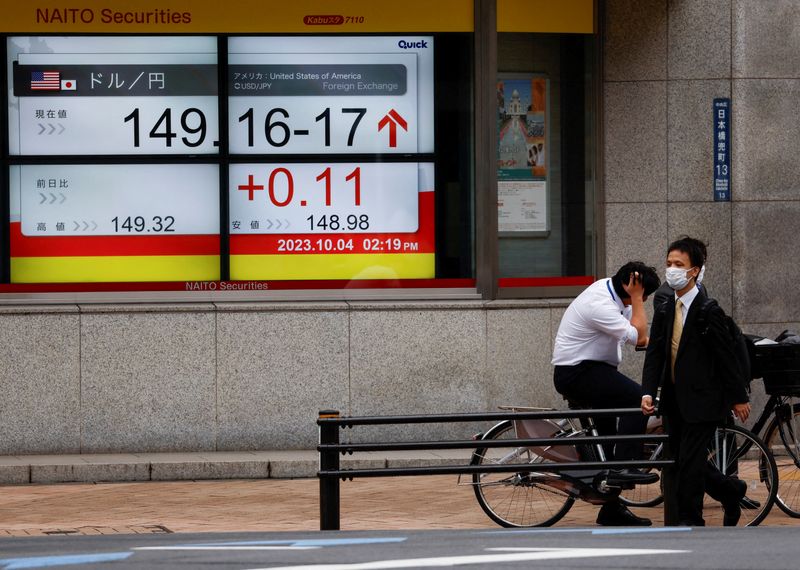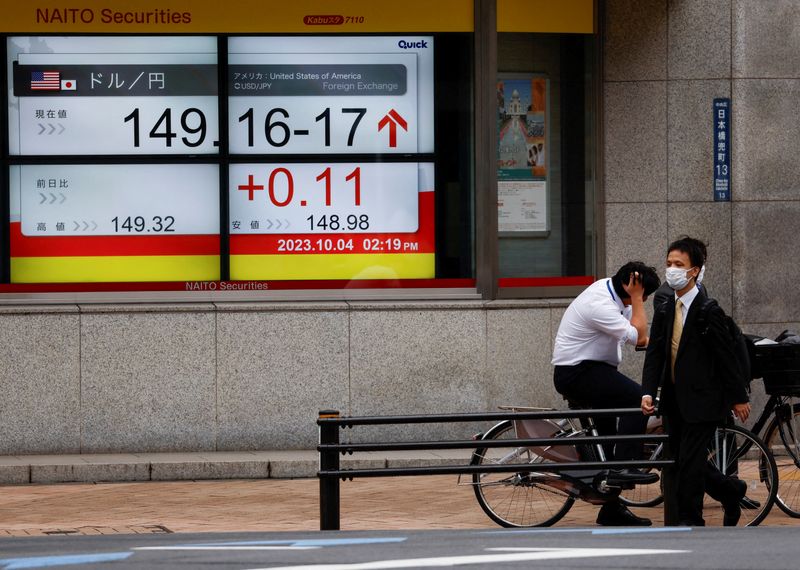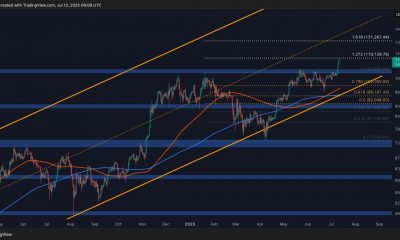Economy
Stocks climb, dollar falls as US inflation moderates


© Reuters. Passersby walk past an electric monitor displaying the Japanese yen exchange rate against the U.S. dollar outside a brokerage in Tokyo, Japan October 4, 2023. REUTERS/Issei Kato/file photo
By Caroline Valetkevitch
NEW YORK (Reuters) -Global stock markets rose while the U.S. dollar hit a near five-month low on Friday after data showed that annual U.S. inflation slowed further below 3% in November, supporting the view that the Federal Reserve could cut borrowing costs next year.
The Commerce Department report also showed U.S. prices fell in November for the first in more than 3-1/2 years.
The data is the last major release this year, and many investors are expected to be away between Monday’s Christmas Day holiday and New Year’s Day.
Stock investors have cheered recent signs from the Fed on the outlook for rates. At the conclusion of its policy meeting on Dec. 13, the Fed signaled that it had reached the end of its tightening cycle and opened the door to interest rate cuts in the coming year.
The U.S. benchmark is inching closer to its all-time closing high. Reaching a new closing high would have confirmed the benchmark index had been in a bull market since closing at the bear market floor in October 2022.
“The PCE data was very dovish, and, of course, this is the Fed’s primary measure of inflation. But the core being below expectations and the top line also being below expectations is positive for the market, indicative that inflation is declining,” said Tim Griskey, senior portfolio strategist at Ingalls & Snyder in New York.
“It’s more evidence that this is a good environment for investing.”
The rose 31.5 points, or 0.08%, to 37,435.85; the S&P 500 gained 13.26 points, or 0.28%, to 4,760.01; and the added 37.34 points, or 0.25%, to 15,001.21.
All three indexes are on track for their eighth straight week of gains, with the S&P 500 set for its longest weekly winning streak since 2017.
The pan-European index rose 0.12% and MSCI’s gauge of stocks across the globe gained 0.22%.
The U.S. dollar was last down against a basket of currencies 0.13% at 101.65, its lowest since late July.
The index has slipped more than 2% over the last two weeks and is on pace to finish the year down just under 2%.
The dollar also weakened to a near nine-year low against the Swiss franc and was last down 0.15%, back to January 2015 levels when the Swiss National Bank sparked significant volatility by discontinuing its policy of having a minimum exchange rate for the franc against the euro.
Benchmark 10-year Treasury yields were up slightly on the day at 3.096%, with the data seen as largely as expected.
In the energy market, oil prices gained as Middle East tensions persisted after Houthi attacks on ships in the Red Sea.
recently rose 0.32% to $74.13 per barrel and was at $79.51, up 0.15% on the day.
added 0.7% to $2,060.14 an ounce.
In cryptocurrencies, bitcoin eased 0.47% to $43,666, just shy of the eight-month high of $44,729 hit earlier this month..
Economy
Russian central bank says it needs months to make sure CPI falling before rate cuts -RBC


© Reuters. Russian Central Bank Governor Elvira Nabiullina attends a news conference in Moscow, Russia June 14, 2019. REUTERS/Shamil Zhumatov/File Photo
MOSCOW (Reuters) – Russia’s central bank will need two to three months to make sure that inflation is steadily declining before taking any decision on interest rate cuts, the bank’s governor Elvira Nabiullina told RBC media on Sunday.
The central bank raised its key interest rate by 100 basis points to 16% earlier in December, hiking for the fifth consecutive meeting in response to stubborn inflation, and suggested that its tightening cycle was nearly over.
Nabiullina said it was not yet clear when exactly the regulator would start cutting rates, however.
“We really need to make sure that inflation is steadily decreasing, that these are not one-off factors that can affect the rate of price growth in a particular month,” she said.
Nabiullina said the bank was taking into account a wide range of indicators but primarily those that “characterize the stability of inflation”.
“This will take two or three months or more – it depends on how much the wide range of indicators that characterize sustainable inflation declines,” she said.
The bank will next convene to set its benchmark rate on Feb. 16.
The governor also said the bank should have started monetary policy tightening earlier than in July, when it embarked on the rate-hiking cycle.
Economy
China identifies second set of projects in $140 billion spending plan


© Reuters. FILE PHOTO: Workers walk past an under-construction area with completed office towers in the background, in Shenzhen’s Qianhai new district, Guangdong province, China August 25, 2023. REUTERS/David Kirton/File Photo
SHANGHAI (Reuters) – China’s top planning body said on Saturday it had identified a second batch of public investment projects, including flood control and disaster relief programmes, under a bond issuance and investment plan announced in October to boost the economy.
With the latest tranche, China has now earmarked more than 800 billion yuan of its 1 trillion yuan ($140 billion) in additional government bond issuance in the fourth quarter, as it focuses on fiscal steps to shore up the flagging economy.
The National Development and Reform Commission (NDRC) said in a statement on Saturday it had identified 9,600 projects with planned investment of more than 560 billion yuan.
China’s economy, the world’s second largest, is struggling to regain its footing post-COVID-19 as policymakers grapple with tepid consumer demand, weak exports, falling foreign investment and a deepening real estate crisis.
The 1 trillion yuan in additional bond issuance will widen China’s 2023 budget deficit ratio to around 3.8 percent from 3 percent, the state-run Xinhua news agency has said.
“Construction of the projects will improve China’s flood control system, emergency response mechanism and disaster relief capabilities, and better protect people’s lives and property, so it is very significant,” the NDRC said.
The agency said it will coordinate with other government bodies to make sure that funds are allocated speedily for investment and that high standards of quality are maintained in project construction.
($1 = 7.1315 renminbi)
Economy
Russian central bank says it needs months to make sure CPI falling before rate cuts -RBC


© Reuters. Russian Central Bank Governor Elvira Nabiullina attends a news conference in Moscow, Russia June 14, 2019. REUTERS/Shamil Zhumatov/File Photo
MOSCOW (Reuters) – Russia’s central bank will need two to three months to make sure that inflation is steadily declining before taking any decision on interest rate cuts, the bank’s governor Elvira Nabiullina told RBC media on Sunday.
The central bank raised its key interest rate by 100 basis points to 16% earlier in December, hiking for the fifth consecutive meeting in response to stubborn inflation, and suggested that its tightening cycle was nearly over.
Nabiullina said it was not yet clear when exactly the regulator would start cutting rates, however.
“We really need to make sure that inflation is steadily decreasing, that these are not one-off factors that can affect the rate of price growth in a particular month,” she said.
Nabiullina said the bank was taking into account a wide range of indicators but primarily those that “characterize the stability of inflation”.
“This will take two or three months or more – it depends on how much the wide range of indicators that characterize sustainable inflation declines,” she said.
The bank will next convene to set its benchmark rate on Feb. 16.
The governor also said the bank should have started monetary policy tightening earlier than in July, when it embarked on the rate-hiking cycle.

 Forex3 years ago
Forex3 years agoForex Today: the dollar is gaining strength amid gloomy sentiment at the start of the Fed’s week

 Forex3 years ago
Forex3 years agoUnbiased review of Pocket Option broker

 Forex3 years ago
Forex3 years agoDollar to pound sterling exchange rate today: Pound plummeted to its lowest since 1985

 Forex3 years ago
Forex3 years agoHow is the Australian dollar doing today?

 Cryptocurrency3 years ago
Cryptocurrency3 years agoWhat happened in the crypto market – current events today

 World3 years ago
World3 years agoWhy are modern video games an art form?

 Commodities3 years ago
Commodities3 years agoCopper continues to fall in price on expectations of lower demand in China

 Economy3 years ago
Economy3 years agoCrude oil tankers double in price due to EU anti-Russian sanctions



























